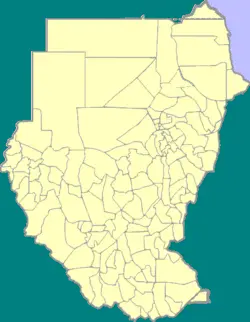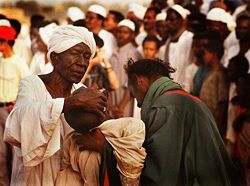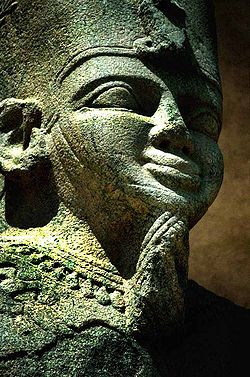Difference between revisions of "Khartoum" - New World Encyclopedia
Mike Butler (talk | contribs) |
Mike Butler (talk | contribs) |
||
| Line 134: | Line 134: | ||
| − | |||
| − | |||
Revision as of 01:00, 14 December 2008
| Khartoum الخرطوم al-Kharṭūm |
|||
| The old Mosque of Khartoum | |||
|
|||
| Nickname: The Triangular City | |||
| Khartoum's location in Sudan | |||
| Coordinates: 15°34′N 33°36′E | |||
|---|---|---|---|
| Government | |||
| - Governor | Abdul Halim al Mutafi | ||
| Population (2005) | |||
| - Urban | 2,207,794 | ||
| - Metro | 8,363,915 Agglomeration | ||
Khartoum (الخرطوم al-Kharṭūm) is the capital of Sudan and of Khartoum State. It is located at the confluence point of the White Nile flowing north from Lake Victoria, and the Blue Nile flowing west from Ethiopia. The location where the two Niles meet is known as "al-Mogran". The main Nile continues to flow north towards Egypt and the Mediterranean Sea.
Divided by the Niles, Khartoum is a tripartite metropolis consisting of Khartoum proper, and linked by bridges Khartoum North called (al-Khartūm Bahrī) and Omdurman (Umm Durmān) to the west.
Geography
The word Khartoum means elephant’s trunk in the local dialect, and is probably derived from the narrow strip of land between the blue and White Niles, which is like the trunk of an elephant. [1]
Topography: Physical qualities of a particular place. Example: Mexico City a. Mountain flanked basin b. on dry lake bed c. vulnerability to earthquakes d. trapped air pollution (also true in L.A. and Athens)
Elevation 1265 feet (386 meters)
Khartoum’s average maximum temperature is over 100°F (38°C) and prevails from February to November. An average maximum of 94°F (34°C) characterizes the remaining two months. Sandstorms (huboobs) are common from May until August. Mean annual precipitation is 6.2 inches (157.5mm).
Districts
History
Early history
Ibrahim Pasha, the adopted son of Muhammad Ali, the ruler of Egypt, founded Khartoum in 1821 as an outpost for the Egyptian army, but the settlement grew as a regional center of trade, including the slave trade. Troops loyal to the Mahdi Muhammad Ahmad began a siege of Khartoum on March 13, 1884 against the defenders led by British General Charles George Gordon. The siege resulted in the massacre of the Anglo-Egyptian garrison.
The heavily damaged city fell to the Mahdists on January 26, 1885. Omdurman was the scene of the bloody battle on September 2, 1898, during which British forces under Horatio Kitchener defeated the Mahdist forces defending the city.
In 1899, Khartoum became the capital of Anglo-Egyptian Sudan and, with the independence of Sudan in 1956, the capital of the new country.
Recent history
In 1973, the city was the site of a hostage crisis in which members of Black September held ten hostages at the Saudi embassy, five of whom were diplomats. The US ambassador, the US deputy ambassador, and the Belgian chargé d'affaires were murdered. The remaining hostages were released (see 1973 Khartoum diplomatic assassinations). A 1973 United States Department of State document, declassified in 2006, concluded "The Khartoum operation was planned and carried out with the full knowledge and personal approval of Yasser Arafat."[2]
The first oil pipeline between Khartoum and Port Sudan was completed in 1977.
Throughout the 1970s and 1980s, Khartoum was the destination for hundreds of thousands of refugees fleeing conflicts in neighboring nations such as Chad, Eritrea, Ethiopia and Uganda. The refugees settled in large slums at the outskirts of the city. From the mid-1980s onward, large numbers of internally displaced from the violence of the Second Sudanese Civil War and Darfur conflict have settled around Khartoum.
Following the 1998 U.S. embassy bombings, the United States accused Osama bin Laden's al-Qaeda group of responsibility and launched cruise missile attacks (August 20) on the al-Shifa pharmaceutical factory in Khartoum North. The destruction of the factory produced diplomatic tension between the U.S. and Sudan.
After the sudden death of SPLA head and vice-president of Sudan John Garang at the end of July 2005, there were violent riots in the capital for some days. The death toll was at least 24 as youth from South Sudan attacked North Sudanese and clashed with security forces.[3]
The Arab League summit of March 28-29, 2006 was held in Khartoum, during which the Arab League awarded Sudan the Arab League presidency.
Khartoum's Unity High School came to international attention on November 25, 2007, when one of its teachers, Gillian Gibbons, from Liverpool, England, was arrested by Sudanese authorities for allegedly insulting Islam by allowing the children in her class to name a teddy bear "Muhammad".[4][5]
On 10 May 2008 the Darfur rebel group of the Justice and Equality Movement moved into the city where they engaged in heavy fighting with Sudanese government forces. Their goal was the toppling of Omar Hassan al-Bashir's government, though the Sudanese government succeeded in beating back the assault[6][7].[8]
Government
Sudan has a Government of National Unity, consisting of the National Congress Party and Sudan People's Liberation Movement, who formed a power-sharing government under the 2005 Comprehensive Peace Agreement. The National Congress Party, which came to power by military coup in 1989, is the majority partner. The agreement stipulates national elections in 2009
Economy
Sudan's economy was booming in 2008 on the back of increases in oil production, high oil prices, and large inflows of foreign direct investment. GDP growth registered more than 10 percent per year in 2006 and 2007. Agricultural production remains important, because it employs 80 percent of the work force and contributes a third of GDP. The Darfur conflict, the aftermath of two decades of civil war in the south, the lack of basic infrastructure in large areas, and a reliance by much of the population on subsistence agriculture ensure much of the population will remain at or below the poverty line for years despite rapid rises in average per capita income.
Per capita GDP was estimated at $1900 in 2007.
Although poor, with few paved streets, Khartoum is a trade and communications centre, with rail lines from Egypt, Port Sudan, and El Obeid, river traffic on the Blue and White Nile rivers, and Khartoum International Airport, is located in the heart of the city. A new international airport was under construction in 2008 in the city of Omdurman.
It has four bridge connections across the Blue Nile to Khartoum North, and four (with two more proposed in 2008) across the White Nile to Omdurman. The three cities form The Sudan’s largest conurbation.
Financial and business services sector
Tourism
Industries include printing, glass manufacturing, food processing, gums and textiles.
Petroleum products are produced in the north of Khartoum state, providing fuel and jobs for the city. One of Sudan's largest refineries is located in northern Khartoum. An oil pipeline between Khartoum and Port Sudan was completed in 1977.
Demographics
The population of Khartoum city was estimated at 2,207,794 in 2005, while 8,363,915 lived in the agglomeration. Sudan also has faced large refugee influxes from neighboring countries, primarily Ethiopia and Chad.
Black people make up 52 percent of Sudan's population, Arab 39 percent, Beja 6 percent, foreigners 2 percent, and others 1 percent.
Arabic is the official language. English is widely spoken, and is an o0fficial language. More than 100 languages and dialects are identified, including Nubian, Ta Bedawie, diverse dialects of Nilotic, Nilo-Hamitic, Sudanic languages. A program of "Arabization" was in progress in 2008.
Sunni Muslims, which make up 70 of Sudan's population, are concentrated in the north, Christians make up 5 percent and are mostly in south and Khartoum, while 25 percent follow indigenous beliefs.
Khartoum is the location of the University of Khartoum, founded as Gordon Memorial College in 1902 and renamed in the 1930s, Juba University, which is the only university in Sudan to maintain English as language of instruction, Computerman College, Al Neelain University, Sudan University of Science and Technology, Bayan Science and Technology University, the Academy of Medical Sciences and Technology, Omdurman Islamic University, Ahfad University for Women, the Academy of Medical Sciences and Technology, and the Comboni College for Science and Technology.
Of interest
Museums
The largest museum in Khartoum, and indeed all of Sudan, is the National Museum of Sudan. Founded in 1971, it contains works from different epochs of Sudanese history. Among the exhibits are two Egyptian temples of Buhen and Semna which were originally built by Queen Hatshepsut and Pharaoh Tuthmosis III respectively but relocated to Khartoum upon the flooding of Lake Nasser.
Another museum in Khartoum is the Palace Museum, located adjacent to the historical Presidential Palace on Blue Nile Street.
Shopping
Khartoum doesn't have as many open markets or souqs as neighboring Omdurman, but one of the largest is the Souq Arabi. The market is huge and spread over several blocks in the center of Khartoum proper just south of the Great Mosque (Mesjid al-Kabir) and the minibus station. It is divided into separate sections, including one focused entirely on gold.
Al Qasr St. and Al Jamhoriyah St. are considered the most famous high streets in Khartoum State.
Located in the southern suburb Arkeweet, recently the first medium scale shopping mall opened. Afra Mall mall with a supermarket, retail outlets, coffee shops, a bowling alley, and a movie theatre.
Botanical Gardens
Khartoum is home to a small botanical garden, in the Mogran district of the city.
Clubs
Khartoum is home to several clubs such as the Sailing Club, German Club, Greek Hotel, Coptic Club, Syrian Club, International Club etc.
ReferencesISBN links support NWE through referral fees
- ↑ C.E.J. Walkly, cited without further details on the website of the US Embassy.
- ↑ The Seizure of the Saudi Arabian Embassy in Khartoum. U.S. Department of State (2006-05-04).
- ↑ BBC NEWS | World | Africa | Riots after Sudan VP Garang dies
- ↑ "'Muhammad' teddy teacher arrested", BBC, 2007-11-26. Retrieved 2007-11-28.
- ↑ Rob Crilly in Khartoum and Lucy Bannerman. "Sudan police throw teacher in jail for teddy bear named Muhammad", The Times, 2007-11-27. Retrieved 2007-11-28.
- ↑ Curfew in capital as Sudanese army clash near Khartoum with Darfur rebels - Sudan Tribune 2008-05-10
- ↑ Sudanese rebels 'reach Khartoum' - BBC News 2008-05-10
- ↑ PHOTOS: Sudan capital after today's attack from Darfur JEM - Sudan Tribune 2008-05-10
Further reading
- Atteridge, A. Hillia. Towards Khartoum: the Story of the Sudan. 2007. Gardners Books. ISBN 9781432651435
- Butler, Daniel Allen. 2007. The first Jihad: the battle for Khartoum, and the dawn of militant Islam. Havertown, Pa: Casemate. ISBN 9781932033540
- Chenevix Trench, Charles. 1979. The road to Khartoum: a life of General Charles Gordon. New York: Norton. ISBN 9780393012378
- Collins, Robert O. 2005. "Khartoum". Encyclopedia of African History. 764-765.
OCLC 143619337
- Farwell, Byron. 1967. Prisoners of the Mahdi; the story of the Mahdist revolt which frustrated Queen Victoria's designs on the Sudan, humbled Egypt, and led to the fall of Khartoum, the death of Gordon, and Kitchener's victory at Omdurman fourteen years later. New York: Harper & Row. OCLC 420988
- Kudrati M, ML Plummer, and ND Yousif. 2008. "Children of the sug: a study of the daily lives of street children in Khartoum, Sudan, with intervention recommendations". Child Abuse & Neglect. 32 (4): 439-48. OCLC 264289953
- Reeves, Eric. 2001. "ARTICLES - RAPACIOUS INSTINCTS IN SUDAN - Oil companies are partners with Khartoum in waging a cruel civil war". The Nation. 272 (22): 23. OCLC 93119728
- Walt, V. 2007. "Khartoum Boom". FORTUNE -EUROPEAN EDITION-. 156 (3): 30-37. OCLC 210395286
External links
- Encyclopaedia Britannica Khartoum Retrieved December 13, 2008.
- World Fact Book 2008 Sudan Retrieved December 13, 2008.
- U.S. Department of State Khartoum: Sudan Retrieved December 13, 2008.
- American Geographical Society The Growth and Functional Structure of Khartoum Retrieved December 13, 2008.
- Earth from Space - Khartoum
- GNS: Country Files - National Geospatial-Intelligence Agency
- Al-Sunut Development Project - Al-Sunut Development Company LTD
Coordinates:
- [1] - Khartoum and Khartoum Variations are titles of Corwood Industries releases #0781 and #0782, respectively. (Corwood Industries PO Box 15375 Houston TX 77220)
Credits
New World Encyclopedia writers and editors rewrote and completed the Wikipedia article in accordance with New World Encyclopedia standards. This article abides by terms of the Creative Commons CC-by-sa 3.0 License (CC-by-sa), which may be used and disseminated with proper attribution. Credit is due under the terms of this license that can reference both the New World Encyclopedia contributors and the selfless volunteer contributors of the Wikimedia Foundation. To cite this article click here for a list of acceptable citing formats.The history of earlier contributions by wikipedians is accessible to researchers here:
The history of this article since it was imported to New World Encyclopedia:
Note: Some restrictions may apply to use of individual images which are separately licensed.






